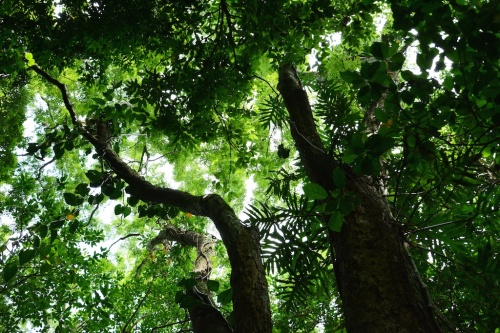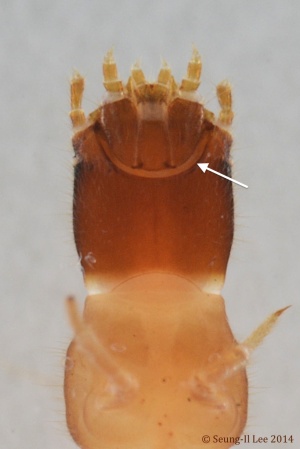
Upis ceramboides (adult, dorsal view)

Upis ceramboides (larval head, dorsal view)
Upis ceramboides (Linnaeus) is known as a ‘roughened darkling beetle’ (a.k.a. Alaskan darkling beetle) because of a characteristic pattern of its elytra. This species can be found under bark of aspen (Populus spp.), birch (Betula spp.), and maple (Acer spp.) trees in North America, Europe, and Asia (Kaufmann, 1969).
I had a chance to take pictures of this species on a dead aspen log at the Ecosystem Management Emulating Natural Disturbance (EMEND) research site in Alberta, Canada. The larva was found under bark of aspen log. It is not quite sure what they eat in nature, however, it is known that larvae feed on a variety of foods (e.g., sweet potatoes, apples, cereals, cooked meat, dead insects) in the laboratory condition. Unfortunately, I was not able to observe its feeding habit since I collected the latest instar larva which was very close to the pupal stage.
Like many other invertebrates that are adapted to very cold temperature in Canadian boreal forest, U. ceramboides can survive up to -60 °C or lower. Interestingly, this darkling beetle produces non-protein antifreeze molecule called xylomannan (Walters et al., 2009).
Due to the extensive logging and habitat fragmentation, U. ceramboides has been largely decreased and designated as a ‘vulnerable’ species in the Swedish red list (Naalisvaara, 2013).
*Click the link below to see more photos! https://biobeetle.wordpress.com/adult-beetles/tenebrionidae/
References:
Kaufmann, T., 1969. Life history of Upis ceramboides at Fairbanks, Alaska. Annals of the Entomological Society of America 62, 922-923.
Naalisvaara, R., 2013. Clear-cut and substrate characteristics important for the occurrence of the beetle Upis ceramboides. MSc thesis. Department of Ecology, Swedish University of Agricultural Sciences, Sweden.
Walters, K.R., Jr., Serianni, A.S., Sformo, T., Barnes, B.M., Duman, J.G., 2009. A nonprotein thermal hysteresis-producing xylomannan antifreeze in the freeze-tolerant Alaskan beetle Upis ceramboides. Proceedings of the National Academy of Sciences of the United States of America 106, 20210-20215.
























